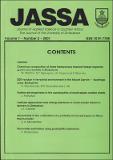| dc.contributor.author | Matizha, W. | |
| dc.contributor.author | Ngongoni, N.T. | |
| dc.contributor.author | Topps, J.H. | |
| dc.contributor.author | Sibanda, S. | |
| dc.coverage.spatial | Zimbabwe. | en |
| dc.date.accessioned | 2016-03-01T12:47:32Z | |
| dc.date.available | 2016-03-01T12:47:32Z | |
| dc.date.issued | 2001 | |
| dc.identifier.citation | Matizha, W. et al., (2001) Chemical composition of three herbaceous tropical forage legumes grown successfully in Zimbabwe, Journal of Applied Science in Southern Africa, vol. 7, no.2, pp. 73-83. Harare: UZ Publications. | en |
| dc.identifier.issn | 1019-7788 | |
| dc.identifier.uri | https://opendocs.ids.ac.uk/opendocs/handle/20.500.12413/9640 | |
| dc.description | A scientific study on animal- feed nutrition for better stock production in Zimbabwe. | en |
| dc.description.abstract | Desmodium uncinatum, Stylosanthes guianensis and Macroptilium atropurpureum, grown at the University of Zimbabwe Farm, were harvested serially in the early (December), mid (February) and late (April) growing season in 1992/93 and oven-dried. Field-cured hays were also made from the legumes in April 1993 and 1994. The legumes differed in phenological development which, in turn, influenced crude protein (CP) levels. The CP content of S. guianensis (132 to 167 g/kg dry matter) was the least and first rose and then fell, that of D. uncinatum (195 to 234 g/kg DM) decreased, while that of M. atropurpureum (189 to 229 g/kg DM) increased with the season. Neutral detergent fibre (NDF) was higher in the early (364 to 440 g/kg DM) than in the mid to late season (470 to 559 g/kg DM). S. guianensis was the most fibrous in April, while D. uncinatum contained the most lignin across the season (148 to 159 g/kg DM). The legumes, especially M. atropurpureum, were rich in calcium (9.8 to 20.4 g/kg DM) and phosphorus (1.8 to 3.3 g/kg DM). Hay making was associated with loss of quality (e.g., 14 to 31 percent less CP and 12 to 51 percent more NDF) that was attributable to leaf loss. D. uncinatum hay contained the most fibre, lignin and acid detergent insoluble nitrogen and the least minerals. It is concluded that, overall,
M. atropurpureum was chemically the most nutritious legume. | en |
| dc.language.iso | en | en |
| dc.publisher | University of Zimbabwe (UZ) Publications | en |
| dc.rights.uri | http://creativecommons.org/licenses/by-nc-nd/3.0/ | en |
| dc.subject | Agriculture | en |
| dc.subject | Nutrition | en |
| dc.subject | Science and Society | en |
| dc.title | Chemical composition of three herbaceous tropical forage legumes grown successfully in Zimbabwe | en |
| dc.type | Article | en |
| dc.rights.holder | University of Zimbabwe (UZ) | en |


